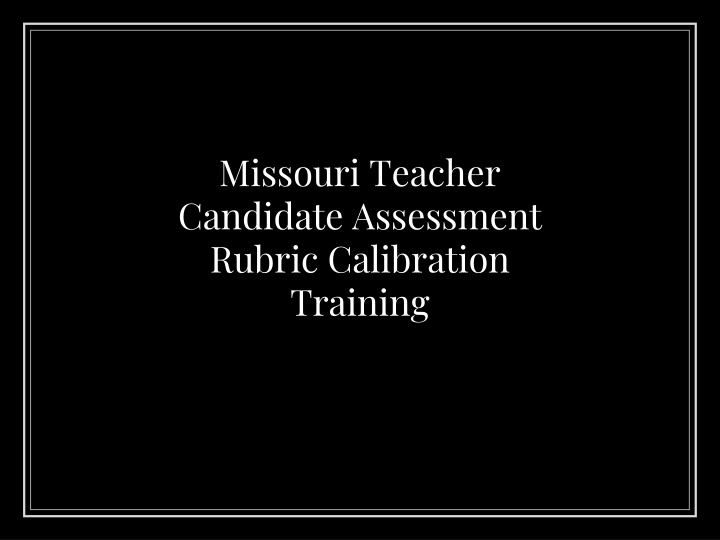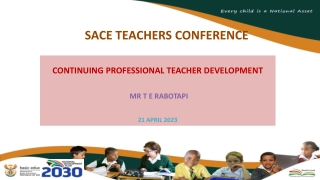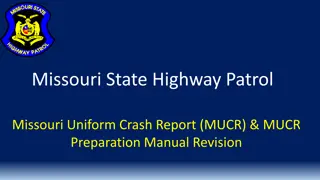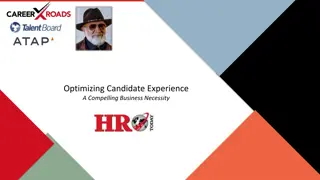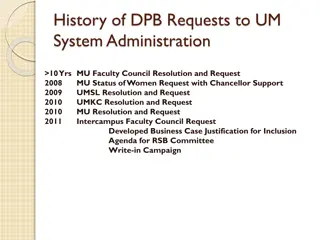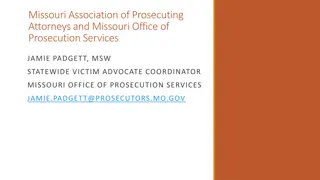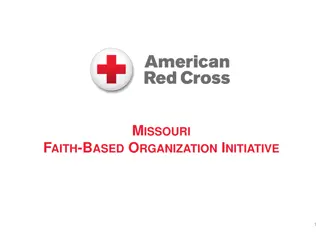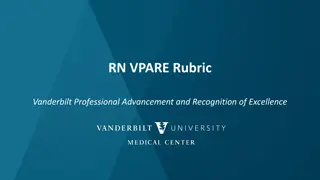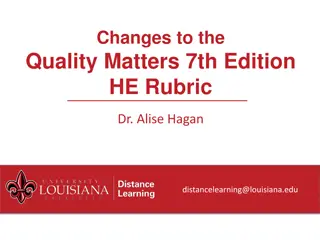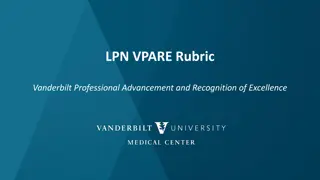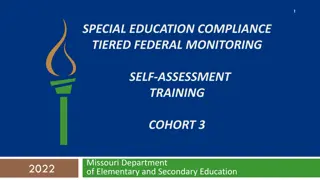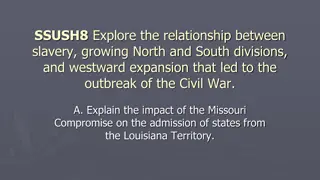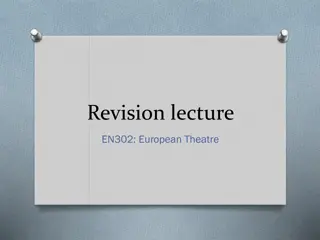Missouri Teacher Candidate Assessment Rubric Training
This training provides insights into the Missouri Teacher Candidate Assessment Rubric, its significance, and the criteria for scoring. It covers important terms, objectives, and the standards expected of professional teachers in Missouri. The training aims to enhance knowledge and calibration for teacher certification.
Download Presentation

Please find below an Image/Link to download the presentation.
The content on the website is provided AS IS for your information and personal use only. It may not be sold, licensed, or shared on other websites without obtaining consent from the author.If you encounter any issues during the download, it is possible that the publisher has removed the file from their server.
You are allowed to download the files provided on this website for personal or commercial use, subject to the condition that they are used lawfully. All files are the property of their respective owners.
The content on the website is provided AS IS for your information and personal use only. It may not be sold, licensed, or shared on other websites without obtaining consent from the author.
E N D
Presentation Transcript
Missouri Teacher Candidate Assessment Rubric Calibration Training
This training is a partnership of DESE & MACTE 2
Objectives of Online Training 1. Knowledge of Missouri Teacher Candidate Assessment Rubric protocol and rationale of its use 1. Calibration of scoring for the Missouri Teacher Candidate Assessment Rubric 3
Important Terms Missouri Teacher Standards: see next slide Teacher Candidate: Also called student teacher, intern. Student in an initial teacher preparation program completing the culminating field experience, traditionally called student teaching. Cooperating teacher: individual employed by the school district and assigned to supervise the teacher candidate. Also called mentor teacher. University supervisor: individual employed by the educator preparation program who directly supervises teacher candidates in the field. Educator preparation program or EPP: university, college, or organization preparing the teacher candidate, responsible for recommending teacher candidates for certification. 4
Missouri Teacher Standards Nine standards that convey the expectations of performance for professional teachers in Missouri. These can be aligned with the InTASC standards. Unfamiliar with these? Click here to view them. 5
Missouri Teacher Standards Standard 1: Content knowledge aligned with appropriate instruction Standard 2: Student learning, growth, and development Standard 3: Curriculum implementation Standard 4: Critical thinking Standard 5: Positive classroom environment Standard 6: Effective communication Standard 7: Student Assessment and Data Analysis Standard 8: Professionalism Standard 9: Professional collaboration 6
2. Why do I need training? Missouri Teacher Candidate Assessment Rubric 7
Teacher Candidate Assessment Rubric Every teacher candidate in the state will be evaluated by their cooperating teacher and university supervisor using the same instrument. Candidates must receive a specified score to receive teacher certification. Scores are reported on the EPP Annual Performance Report. 8
Calibration on Teacher Candidate Assessment Rubric is important. The rubric provides feedback to the candidate on his or her performance. 9
Teacher Candidate Assessment Throughout the clinical experience, teacher candidates receive feedback. You will receive specifics on the frequency and type of formative feedback from the EPP. Assessment includes observation of performance and other evidence and artifacts. Each of the nine teacher standards must be assessed by the end of student teaching. Both the cooperating teacher and university supervisor must submit a score on every standard. 10
3. Rubric Design Observable behaviors and evidence provided by teacher candidate 11
9 Teacher Standards The same standards used for practicing teachers. Score of 0-4 on each Certification assessment 3 is the target by the summative evaluation. 12
Overall Guide to Levels of Performance Language in the rubric (descriptors) is what matters. 0=No evidence of performance 1=Plans or intends to use the skill but does not implement in performance 2=Attempted to implement but may not have been successful or effective 3=Target performance for teacher candidate 4=Only used if all descriptors for level 3 have been met. 13
Lets look at the first part of the rubric. Note the progression from 0 to 3 across the strands. 14
Teacher Candidate Assessment Rubric Each standard has multiple strands describing observable behaviors. Highlight the descriptor that is appropriate for the performance or evidence you observed throughout the semester. Comment to explain your score. The score is calculated based on the column where the majority of strands are highlighted. 15
4. Scoring Protocol Review the rubric. You will be prompted to make a copy of this document in your Google Drive. https://docs.google.com/document/d/1RcBvCHexl8bPmeTxnAJCt3P10i Fole7gMHY34NrKsNE/copy?usp=sharing Don t want to use Google? Access the document in PDF here: https://dese.mo.gov/sites/default/files/MEESTeacherCandidateAssessm entRubricUpdated2019FINAL.pdf Review the scoring protocol https://dese.mo.gov/sites/default/files/MEESTeacherCandidateSummativeSco ringProtocol2019-2020.pdf 16
How to Score What evidence was observed or documentation provided by the candidate? Each standard is a separate score. A candidate may be strong on one but not on another. The score is not how much we like the candidate or their potential The score is not about what they could have done during the observation If unsure on a score, use the language on the rubric. Highlight what was observed. Ask yourself, Why not the higher score? Why not the lower score? Think about how a conference with the teacher candidate would work. What feedback would you give? 17
Scoring Protocol 1. For levels 0 3, a score earned on a majority of the strands will be the score assigned to that standard. 2. For standards with an even number of strands, if the scores are split evenly between two adjacent levels, the lower score will be given. 3. If neither of the first two rules applies, the mean of all strand scores should be calculated and used as the standard score. This score should be rounded down if the mean is *.5 or lower and rounded up if it is greater than *.5. https://dese.mo.gov/sites/default/files/MEESTeacherCandidateRubricScoringProtocol2019- 2020FINAL.pdf 18
Summative Scoring Based on what you observed and evidence, not candidate s potential. Many EPPs will have midterm and formative feedback requirements. The language is designed to be evidence-based and positive, based on what is, rather than what is missing or lacking. In the next example you will see a Standard 1 score of 2. Note that the candidate scored in the 1 column for the last row. The score is calculated on the majority of rows selected. 19
Example of Rule 1: Score of 2 20
For a score of 4, the candidate must have ALL strands in the 3 column selected and at least one from the 4 column. 23
If youre not sure what score . . . Scores are reported as whole numbers. If you have any questions, refer to p. 8-11 of the protocol or ask your EPP university supervisor. Any questions? Please contact your Educator Preparation Program field experience office. 24
THANK YOU! The mentoring you provide to the teacher candidates is essential to their preparation. Teacher preparation is partnership. 25
Credits Special thanks to all the people who made and released these awesome resources for free: Presentation template by SlidesCarnival Photographs by Unsplash 26
